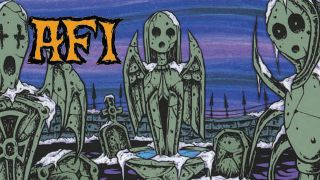Long before My Chemical Romance topped the charts with the anthemic ‘Welcome to the Black Parade’, California’s AFI were already injecting their brand of punk with gothic imagery and a sense of theatricality. By the time Gerard Way’s band arrived, AFI had already built a devoted fan base incorporating punks, hardcore fans, goths, metallers and every other type of musical pariah imaginable. They were a band that couldn’t help but stand out everywhere they went.

Such uniqueness within the punk scene meant AFI achieved a level of independence out of step with their West Coast peers. That specific area of America was responsible for the majority of sun-soaked punk bands earning themselves success in the ’90s. For a band like AFI however, harnessing the cold, dark nights of winter proved far more beneficial when establishing their sound.
The Art of Drowning came out in 2000 and was AFI’s last release via The Offspring’s frontman Dexter Holland’s independent label Nitro Records. AFI were already well known for their Misfits-inspired lightning-fast punk but The Art of Drowning painted a more vivid picture of who the band really were. It’s an album that explores more of AFI’s own influences without compromising the sound they had spent a career perfecting.
The rowdy punk attitude is still represented on tracks like The Lost Souls, Sacrifice Theory, Smile and A Story at Three. These healthy chunks of fury and melody complement AFI’s earlier works showcasing each member’s definitive style. Lead singer Davey Havok’s desperate shrills backed up by huge gang vocals; Jade Puget’s roaring guitars; Hunter Bergan’s psychobilly-esque bass and Adam Carson’s crashing drums combine to forge quintessential AFI anthems.
Davey Havok remains one of the most important punk figures of recent times. Even early on in AFI’s career he stood out for his shadowy appearance and effeminate mannerisms. On The Art of Drowning, Havok reveals a greater depth to his vocal performances by displaying various levels of emotion. The slow and brooding Ever And A Day is the first notable step away from the usual aggressive hardcore of previous AFI records. Havok delivers the vocals so softly that it almost feels as though he’s next to you, whispering in your ear. It’s the same style of singing that kicks off 6 To 8 and Morningstar, prime examples of AFI’s leaning towards more dynamic alternative rock song writing.
Elsewhere is the album’s runaway hit, The Days of the Phoenix, a perfect amalgamation of AFI’s widely recognised raw vivaciousness with Havok’s new penchant for singing without screaming. Once you sprinkle the type of melodic chorus that AFI have delivered over and over again you’re left with a bona fide radio hit and soon everyone took notice.
The clubs were far too small for AFI’s dramatic reinvention and the soaring choruses of tracks like the aforementioned Ever And A Day and 6 To 8 could only ever work properly on a bigger stage. Following the release of The Art Of Drowning, their transition into the mainstream was inevitable.

